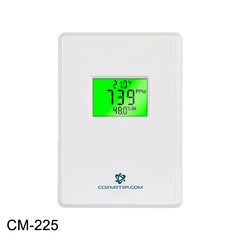
Ensuring sufficient air quality is a vital part of creating a healthy indoor air environment.
The U.S. Green Building Council is a non-profit organization that promotes sustainability in building design, construction, and operation. Like an ISO rating for building design, they have created specific LEED standards that give a rating to each building based on improved air quality and minimized power usage.
CO2 monitoring is a part of the overall strategy designed to meet LEED standards. Not only can CO2 monitoring minimize energy usage and improve indoor air quality, but with proper CO2 monitors installed individuals can gain points towards the goal of LEED certification.
Although there are many different LEED certification frameworks depending on the type of construction - new vs. retrofit and operations - the rating system is comprised of five categories:
- Sustainable Sites
- Water Efficiency
- Energy and Atmosphere
- Materials and Resources
- Indoor Environmental Quality (IEQ)
How many credits are required for the minimum LEED certification?
In terms of Carbon Dioxide monitoring in LEED certifications, there are two prerequisites in order to gain a point:
1. Minimum Indoor Air Quality Performance - The intent of the Minimum Indoor Air Quality Performance prerequisite is to establish minimum indoor air quality (IAQ) in buildings which contribute to the comfort and well-being of the occupants.
2. Environmental Tobacco Smoke (ETS) Control - The intent of the Environmental Tobacco Smoke Control prerequisite is to prevent or minimize exposure of building occupants, indoor surfaces and ventilation air distribution systems to environmental tobacco smoke.
Once these prerequisites are met, both LEED versions allow for CO2 monitors to be placed in indoor occupied spaces and to be used to monitor IAQ, giving a warning to the occupants if the CO2 levels rise above pre-determined limits.
Using CO2 monitors as part of an overall IAQ strategy is worth at most 1 credit toward the overall LEED rating.
To keep the LEED credit, CO2 sensors must be re-calibrated every 5 years. In addition, the sensors must be accurate to within 75ppm or 5% of the actual CO2 level, whichever is greater.
What is different between LEED v3 and v4?
The most current LEED certification is v4. Before gaining IEQ points in LEED v4, a “green cleaning” prerequisite has been added for commercial buildings. This includes green cleaning procedures, materials, and services that are within the building and site management’s control, and include the organization responsible for cleaning the building and building site.
LEED v4 classifies building projects into one of four standards: Building Design & Construction (BD+C), Interior Design & Construction (ID+C), Building Operations & Maintenance (O+M) and LEED for neighborhood development (ND). Within these standards, there are several new project variations.
For example, in LEED v3, there were project variations under BD+C for new construction, core and shell, schools, retail and healthcare. In LEED v4, new BD+C variations include data centers, hospitality, warehouses, residential homes, and multi-family midrise homes.
What makes this more complicated is that for every project variation, the LEED specification for using CO2 sensors for IAQ is slightly different. However, the most common requirement under the new “Enhanced Indoor Air Quality Strategies” credit category found in most of the projects is:
"Monitor CO2 concentrations within all densely occupied spaces. CO2 monitors must be between 3 and 6 feet (900 and 1,800 millimeters) above the floor. CO2 monitors must have an audible or visual indicator or alert in the building automation system if the sensed CO2 concentration exceeds the setpoint by more than 10%. Calculate appropriate CO2 setpoints using methods in ASHRAE 62.1–2010, Appendix C."
Which CO2 monitor will meet LEED credits?
At CO2Meter, we receive several inquiries a week asking if our devices can serve as a low-cost alternative to wall-mounted CO2 sensors which can control air-flow devices for LEED certification, as defined by the U.S. Green Building Council.
We recommend a permanent CO2 monitor like the CM-225 CO2, Temp, and RH Indoor Air Quality Monitor. With the CM-225, individuals can meet the LEED requirement stating that a permanent CO2 monitoring system must provide:
- Either automatic or manual feedback of CO2 levels
- Generate an alarm when CO2 levels exceed threshold (usually 800ppm)
- Be able to notify a building automation system or display indication by visual/audible alert to building occupants.
The CM-225 meets all of these requirements. It is especially useful for adding a CO2 monitor in a typically unoccupied area not pre-wired to the rest of the building's HVAC system.
See more of our LEED specific products here.
While the LEED standards will continue to evolve overtime, CO2Meter will continue to provide gas detection monitors that help create a healthier indoor environment for our customers around the globe.
For more information on CO2 monitoring, gas detection devices or LEED certification, contact us today.








